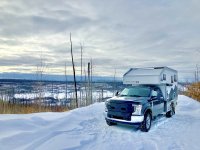SootyCamper
Active member
Weighing the pros/cons of hydronic heating vs going all electric. There are certainly some great perks to the system. If you have experience with these types of systems I'd appreciate your feedback.
Background info: My camper will be spending winters in Northern Alberta so reliable heating is essential. I am heavily considering going all electric as while i'm working the camper will be plugged into free 110v shore power supply(my work place also has showering facilities as well) .
The camper will be running a 48volt system with a 32kwh battery bank (two 16kwh Ruxiu batteries ). This camper will be a fulltime livaboard with residential style 48v mini split heat pump (Mini split ) providing adequate shoulder season heating. If I go all electric I'd utilize Mi Heat 48v floor heating mats (Mi Heat), and a ducted DC air heater (48v Heater 20k btu)
Argument for Hydronic:
Available all in one units from timberline and aqua hot have the benefit of providing hot water on demand aswell as providing cabin heat/floor heat. There are some reliability concerns with these units and they do require maintenance. The heater itself will be housed outside the cabin in a storage box, so only my neighbors will be annoyed by the fuel pump ticking and exhaust blowing
Pros:
- Quiet heating (once floors are heated)
- Less heater cycling
- Dual purpose of cabin heat and hot water
- Availability of engine pre heat (will not be tying into chassis engine coolant for reliability sake, but nice to have the option)
- Ability to reduce battery capacity (will reduce overall weight by 320lbs)
Cons:
- Cost+install is 2x more than electric (rough estimate is $6k USD for heater, $5k for install)
- Reliability concerns( many fittings, pumps, tubes)
- Visible/noisy exhaust
- Reduces interior height
Argument for All electric:
Pros:
- Simple install characteristics, very DIY friendly
- No visible/noisy exhaust = more stealth, less Random citizens thinking the camper is on fire
- minimal impact on interior height
- heat an be "Free" when on shore power
- VERY Cost Effective $1200 for 48v Floor heat + 48v Air heater + thermostats, Additional 48v 16kwh battery is $3300usd = $4500 total
Cons:
- Requires large battery bank (+320lbs to overall build)
- High 48v draw ( forced air at Max 1200 watts, floor pads at max draw 2300watts)
- Will need a electric capable water heater. 240v systems seem to be the most effective which will add complexity + additional inverter.
Open to hearing your insights on this topic. It seems every year there are more and more options coming on the market.
Background info: My camper will be spending winters in Northern Alberta so reliable heating is essential. I am heavily considering going all electric as while i'm working the camper will be plugged into free 110v shore power supply(my work place also has showering facilities as well) .
The camper will be running a 48volt system with a 32kwh battery bank (two 16kwh Ruxiu batteries ). This camper will be a fulltime livaboard with residential style 48v mini split heat pump (Mini split ) providing adequate shoulder season heating. If I go all electric I'd utilize Mi Heat 48v floor heating mats (Mi Heat), and a ducted DC air heater (48v Heater 20k btu)
Argument for Hydronic:
Available all in one units from timberline and aqua hot have the benefit of providing hot water on demand aswell as providing cabin heat/floor heat. There are some reliability concerns with these units and they do require maintenance. The heater itself will be housed outside the cabin in a storage box, so only my neighbors will be annoyed by the fuel pump ticking and exhaust blowing
Pros:
- Quiet heating (once floors are heated)
- Less heater cycling
- Dual purpose of cabin heat and hot water
- Availability of engine pre heat (will not be tying into chassis engine coolant for reliability sake, but nice to have the option)
- Ability to reduce battery capacity (will reduce overall weight by 320lbs)
Cons:
- Cost+install is 2x more than electric (rough estimate is $6k USD for heater, $5k for install)
- Reliability concerns( many fittings, pumps, tubes)
- Visible/noisy exhaust
- Reduces interior height
Argument for All electric:
Pros:
- Simple install characteristics, very DIY friendly
- No visible/noisy exhaust = more stealth, less Random citizens thinking the camper is on fire
- minimal impact on interior height
- heat an be "Free" when on shore power
- VERY Cost Effective $1200 for 48v Floor heat + 48v Air heater + thermostats, Additional 48v 16kwh battery is $3300usd = $4500 total
Cons:
- Requires large battery bank (+320lbs to overall build)
- High 48v draw ( forced air at Max 1200 watts, floor pads at max draw 2300watts)
- Will need a electric capable water heater. 240v systems seem to be the most effective which will add complexity + additional inverter.
Open to hearing your insights on this topic. It seems every year there are more and more options coming on the market.

